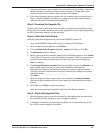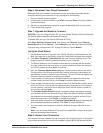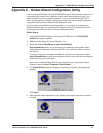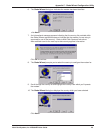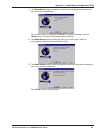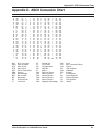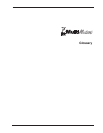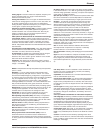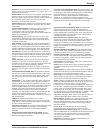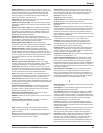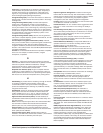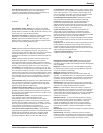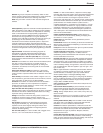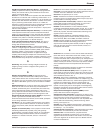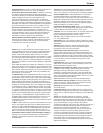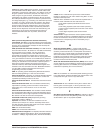
Glossary
Multi-Tech Systems, Inc. MT5634ZPX User Guide 53
Channel: A data communications path between two computer
devices. Can refer to a physical medium (e.g., UTP or coax), or to
a specific carrier frequency.
Channel Bank: A device that acts as a converter, taking the digital
signal from the T1 line into a phone system and converting it to
the analog signals used by the phone system. A channel bank acts
as a multiplexer, placing many slow-speed voice or data
transactions on a single high-speed link.
Characteristics: Those qualities of a Universal Serial Bus device
that are unchangeable; for example, the device class is a device
characteristic.
Circuit-switched Network: A technology used by the PSTN that
allocates a pair of conductors for the exclusive use of one
communication path. Circuit switching allows multiple
conversations on one talk path only if the end-users multiplex the
signals prior to transmission.
Circuit Switching: The temporary connection of two or more
communications channels using a fixed, non-shareable path
through the network. Users have full use of the circuit until the
connection is terminated.
Clear Channel: A transmission path where the full bandwidth is
used (i.e., no bandwidth needed for signaling, carrier framing or
control bits). A 64 Kbps digital circuit usually has 8 Kbps used for
signaling. ISDN has two 64 Kbps circuits, and a 16 Kbps packet
service of which part is used for signaling on the 64K channels.
Client-Server: In TCP/IP, the model of interaction in distributed
data processing in which a program at one site sends a request to
a program at another site and awaits a response. The requesting
program is called a client; the answering program is called a
server.
Cluster Controller: A device that can control the input/output
operations of more than one device connected to it. A cluster
controller may be controlled by a program stored and executed in
the unit, or it may be entirely controlled by hardware.
Committed Burst Size: The maximum number of bits that the
frame relay network agrees to transfer during any measurement
interval.
Committed Information Rate (CIR): An agreement a customer
makes to use a certain minimum data transmission rate (in bps).
The CIR is part of the frame relay service monthly billing, along
with actual usage, that users pay to their frame relay service
provider.
Compression: 1. The process of eliminating gaps, empty fields,
redundancies, and unnecessary data to shorten the length of
records or blocks. 2. In SNA, the replacement of a string of up to
64-repeated characters by an encoded control byte to reduce the
length of the data stream to the LU-LU session partner. The
encoded control byte is followed by the character that was
repeated (unless that character is the prime compression
character). 3. In Data Facility Hierarchical Storage Manager, the
process of moving data instead of allocated space during
migration and recall in order to release unused space. 4. Contrast
with decompression.
COMx Port: A serial communications port on a PC.
Congestion: A network condition where there is too much data
traffic. The ITU I.233 standard defines congestion managemennt
in terms of speed and burstiness.
Congestion notification: The function in frame relay that ensures
that user data transmitted at a rate higher than the CIR are
allowed to slow down to the rate of the available network
bandwidth.
Consecutive Severely Errored Seconds (CSES): An error
condition that occurs when from 3 to 9 SES (Severely Errored
Seconds) are logged consecutively.
Customer Premise Equipment (CPE): The generic term for data
comm and/or terminal equipment that resides at the user site and
is owned by the user with the following exclusions: Over voltage
protection equipment, inside wiring, coin operated or pay
telephones, “company-official” equipment, mobile telephone
equipment, “911” equipment, equipment necessary for the
provision of communications for national defense, or multiplexing
equipment used to deliver multiple channels to the customer.
D
Data Communications Equipment (DCE): Any device which
serves as the portal of entry from the user equipment to a
telecommunications facility. A modem is a DCE for the telephone
network (PSTN) that is commonly on site at the user’s premises.
Packet Switched Networks have another level of DCE which is
most often located at a central office.
Data Link Connection Identifier (DLCI): One of the six
components of a frame relay frame. Its purpose is to distinguish
separate virtual circuits across each access connection. Data
coming into a frame relay node is thus allowed to be sent across
the interface to the specified “address”. The DLCI is confirmed and
relayed to its destination, or if the specification is in error, the
frame is discarded.
Dataphone Digital Service (DDS): A private line digital service
that offers 2400, 4800, 9600 and 56 Kbps data rates on an inter-
LATA basis by AT&T and on an intra-LATA basis by the BOCs.
Data Service Unit (DSU): A device that provides a digital data
service interface directly to the data terminal equipment. The DSU
provides loop equalization, remote and local testing capabilities,
and a standard EIA/CCITT interface.
Dedicated Line: A communication line that is not switched. The
term leased line is more common.
Default: This is a preset value or option in software packages, or
in hardware configuration, that is used unless you specify
otherwise.
Default Address: an address defined by the Universal Serial Bus
Specification and used by a Universal Serial Bus device when it is
first powered or reset. The default address is 00h.
Default Pipe: the message pipe created by Universal Serial Bus
system software to pass control and status information between
the host and a Universal Serial Bus device’s Endpoint 0.
Device: a logical or physical entity that performs a function. The
actual entity described depends on the context of the reference. At
the lowest level, device may refer to a single hardware
component, as in a memory device. At a higher level, it may refer
to a collection of hardware components that perform a particular
function, such as a Universal Serial Bus interface device. At an
even higher level, device may refer to the function performed by
an entity attached to the Universal Serial Bus; for example, a data/
FAX modem device. Devices may be physical, electrical,
addressable, and logical. When used as a non-specific reference,
a Universal Serial Bus device is either a hub or a function.
Device Address: the address of a device on the Universal Serial
Bus. The Device Address is the Default Address when the
Universal Serial Bus device is first powered or reset. Hubs and
functions are assigned a unique Device Address by Universal
Serial Bus software.
Device driver: Software that controls how a computer
communicates with a device, such as a printer or mouse.
Digital Cross-connect System (DCS): The CO device which
splits and redistributes the T1 bandwidth. the DCS takes time slots
from various T1 lines and alters them to provide the needed
connectivity. DCS connections are made with software at an
administrator’s workstation.
Digital Data: Information represented by discrete values or
conditions (contrast “Analog Data”).



